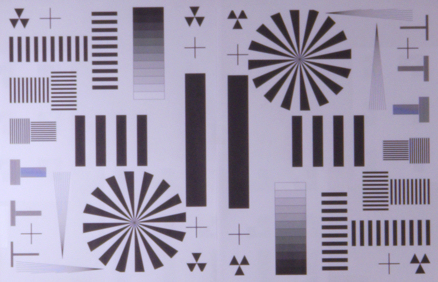
[2006-11-23]
For those who don't want to read the entire page, I'll present a summary of my conclusions up front. On my R1, setting the focus distance to the exact subject distance results in images which are NOT in the "best focus" set of images (the "best focus" set is the set of images which cannot be distinguished from each other by eye at 100% and which are the best focused of all images taken at that focal length and f-stop). This occurs at telephoto focal lengths (3x, 3.5x, and 4x for sure, I haven't tested the others yet) for f-stops less than f11 (tests were done at 5m and 10m distances). In some cases, the images are obviously not in focus, in other cases they are closer to being in focus, but still distinguishable from the best focused set (DOF concerns images which are "tolerably" in focus but I have no way to measure that objectively). In all cases the full DOF range is in front of the focus distance setting. For f11, the DOF has increased to the point where it is starting to overlap with the focus distance setting, but the majority of the DOF is still in front of the focus distance setting which is not correct (the "normal" DOF range for non-hyperfocal values is 30% in front of the focal point and 70% behind the focal point) [Clarification]. Note that all the tests were done using flexible spot focus, so I can't comment on the other autofocus methods.
This could be considered to be just an issue with the focus distance display value being inaccurate, but autofocus test results show that this is not the case. Since the autofocus does not attempt to measure the distance to the subject, but instead tries to maximize contrast in the image (or a small part of the image if using the flexible spot autofocus), the autofocus values should be independent of the displayed focus distance values. The results show that the autofocus system does reflect the variable focus distances at different focal lengths and the focus values are such that the subject is in better focus than setting the focus distance to the known subject distance, but the focus distance is still sometimes not in the "best focused" set and the majority of the DOF is still in front of the focus distance setting. An exception is for focal length 3.5x at 10m, where the autofocus value of 21m (!) is in the best focused set, but the majority of the DOF is still in front of the focus distance setting.
I have no idea if these results reflect my camera only, or are characteristic of some/all other R1's. It is possible that my R1 has a defect and other R1's are fine. Certainly, many fantastic photos have been taken with the R1 so I don't want to condemn the camera. However, I've noticed many forum postings that question whether someone's R1 is producing in-focus images so it may be that there is a more widespread problem. I assume that most people use autofocus, and the autofocus results show that the system can get fairly close to an in-focus value (perhaps "tolerably" in focus). Also, if the subject is far enough away, the DOF may be large enough to compensate for the seemingly misplaced focal point (I only did tests at 5m and 10m), and if the user selects f11 or above he/she may never notice a problem at all. That said, in actual use I did notice something wrong with autofocus values (larger than expected--now I know why), hyperfocal values not achieving in-focus distant subjects (makes sense since the hyperfocal chart assumes 70% of the DOF is behind the focal point and my tests show that all the DOF is in front of the focus distance setting), and subjects being out of focus despite having good autofocus characteristics (high contrast transitions in the focus area) and good lighting.
So is my R1 usable? Should I send it back to Sony for service? I'd like to find out of other R1's have the same problems--if so, that is the way the camera was made and I don't think Sony would (or could) do anything about it. It's fairly easy to adjust the DOF backward by adding ~25% of the autofocus distance to the manual focus value, and since I almost exclusively use manual focus with the camera on a tripod it is not a big deal (the exception is 3.5x focal length which probably needs a 50% correction at least). Also, shooting at f8 probably isn't ideal, f11 is more likely to achieve acceptable focus using the R1 autofocus (and a quick check here confirms that f11 shouldn't cause diffaction problems). I have gotten some nice photos from my R1 and I really like the ergonomics so I will definitely keep using the camera--it's just good to know what's really happening so I can try to correct for it and improve my chances on getting a nice shot...
I've had my R1 for about 6 weeks now and I really like the camera. The manual zoom and focusing ring are great, especially compared to a P&S camera. The top mounted LCD is perfect for my use: landscape photography with the camera on a tripod. However, there is one problem I have been dealing with: focus. I started out intending to use hyperfocal distance focusing in order to maximize depth of field (DOFMaster). My first attempts were not very successful, since distance objects (essentially at infinity focus) did not appear to be in focus. I did some tests and determined that for a particular focal length and f-stop the appropriate hyperfocal distance value was 50m, not 25m as claimed in the chart. I then stopped using the hyperfocal distance chart and relied on the R1's autofocus system, but I started to realize that the autofocus system seemed to be overestimating the distance to the subject (I was using the moveable spot autofocus method in conjunction with the "push auto" manual autofocus button). I assumed this was due to poor lighting, since the R1 is somewhat notorious for poor autofocus in dim light. I would usually correct the distance to something that seemed more believable and take the photo (as it turns out I was correcting in the wrong direction since I was assuming a normal DOF distribution and accurate focus distance values). I still thought there might be a focus problem, although since I was new to digital camera RAW postprocessing without in-camera sharpening I wasn't 100% convinced.
My suspicions were confirmed when I was photographing a barn on my aunt's farm. I used the autofocus as usual, and when I got home the shots were not in focus (it is impossible to judge focus with either the viewfinder or the LCD on the R1, unfortunately). So I went back with a tape measure and actually measured the distance to the barn and compared it with the autofocus value. They did not agree and then I knew something was wrong. So I began a series of tests to see what was happening.
The series of tests I performed consisted of two types of tests: (1) recording autofocus values at known distances with different zoom settings, f-stops, and exposure values; and (2) photographing a target at known distances with different manual focus settings and f-stops. In both cases the target was a test pattern I created, printed, and attached to a sheet of plywood:

The test pattern was illuminated by two 250-watt tungsten photofloods. The exposure value was set at 0 (proper exposure) using the spot exposure centered on the test pattern. This amount of light was decent at 5m, and perhaps a bit weak at 10m. However, this does not affect the manual focus tests--at most it would only affect the autofocus results (and it doesn't appear to have done so in the few autofocus tests done at 10m).
[Note: A dpreview.com Sony forum member claims that the manual focus distance value displayed on the LCD screen (and viewfinder) can vary up to 10%, especially at longer focal distances. Since this value was utilized in both the autofocus and manual focus tests there is some possibility for error. However, the focal distances here (5m and 10m) are short and the autofocus readings were generally consistent within the four tests for each setting, so I'm assuming this is not a significant source or error.]
So far I have done tests at 5m and 10m. The spot focus box was centered on the two large vertical black bars in the test pattern. The graph below shows the results for 5m at f5.6 (red trace), f8 (blue trace), f11 (magenta trace), and f16 (brown trace):
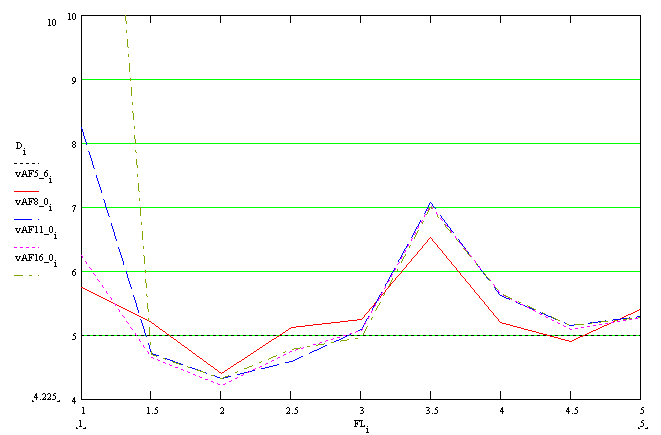
The x-axis of the graph is the focal length of the lens, expressed as a multiple of the minimum focal length of the R1 lens (1 = 14.3mm). The y-axis is the autofocus value in meters. The values are the average of four "push auto" manual autofocus readings. The focus was set to infinity prior to taking each reading. The f-stop should not be a factor, since the the camera will change the aperture to facilitate the autofocus (at least this is what I assumed was happening since I heard the sound of an aperture change and the LCD screen would get brighter when focusing). Indeed, the f8, f11, and f16 curves are almost identical from 1.5x to 5x. There is some variation in the f5.6 curve, but it does follow the general pattern of the other curves. The values at 1x are very different, possibly because the target was too small at 5m to accurately focus the lens. The interesting aspect of this graph is the low values at 2x and the high values at 3.5x. The values at 3.5x for all f-stops execpt 5.6 are 7m, which is 1.4x greater than the actual distance of 5m. Is the R1 misfocusing, or is something else happening? See the manual focus test section for an explanation...
I have only done a few 10m autofocus tests, designed to see if the 5m results still hold at 10m (specifically, the spike at 3.5x). All the tests were at f8, and are averages of four autofocus readings. Here are the results:
| 3x | 9.95 |
| 3.5x | 21.25 |
| 4x | 11.00 |
It's clear that the 5m spike at 3.5x is even more pronounced at 10m, with a value of 21.25m. The other values seem to agree with the curves in the 5m graph. The next test was intended to confirm a suspicion that the exposure value has a effect on the autofocus system. Several times I noticed that changing the exposure setting (in manual mode) seemed to affect the autofocus system. The following graph shows how the autofocus distance changes with set exposure. The x-axis is exposure (-2 stops, -1 stop, 0 stop, +1 stop, +2 stops), and the y-axis is autofocus distance in meters. Two tests were done, one at focal length of 3x (red trace) and another at focal length 4x (blue trace).
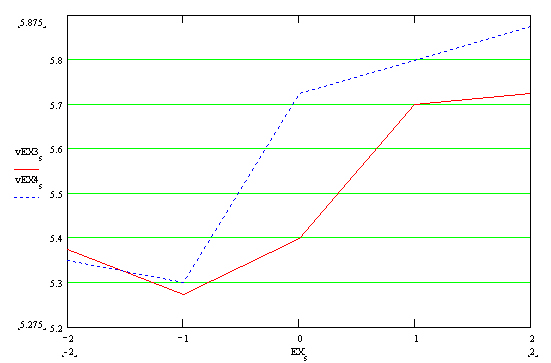
It is clear that exposure does have some affect on the autofocus distance, but it seems to be minor, only 0.5m from -2 stops to +2 stops. This is far less than what I've observed in the field, so there may be some other factor involved.
As a comparison to the R1 autofocus system, I also tested my Contax G1 rangefinder camera's autofocus. I only have one lens for the G1, the 45mm. The autofocus values (averages of 4 readings) for 5m and 10m are shown below.
| 5m | 5.7 |
| 10m | 13.75 |
So the G1 is overestimating the distance to the subject. Without taking some pictures I can't say whether these values make sense, but having used the G1 on a trip to Mexico I don't recall seeing any problem with focus...
The most interesting results come from the manual focus tests. Here, I set the focus manually using the focusing ring and compared the images. Images were recorded at 0.5m intervals up to 10m and 1m intervals for values above 10m (the R1 minimum focusing interval varies with distance). The figures below show 2 or 3 images. For the 3 image figures, the left image shows the focus set the the actual distance from the camera to the test pattern, the middle image shows the closest image taken to the average autofocus value, and the right image shows an image with the best focus. For the 5m distance, the right image shows the image at the median focus value for all images judged equivalently in focus. For the 10m images, the right image shows the image at the minimum focus value for all images judged equivalently in focus (at 10m the DOF is very large, and I didn't shoot enough images at long focus distances to judge the whole range of in-focus images). All images are 100% crops (except where noted) from RAW photos, and the only postprocessing is white balance (no sharpening applied). JPEGs were saved with the smallest possible compression value.
The determination of "equivalently in focus" is to find the set of images that are the most in focus, such that the members of the set cannot be distinguished when viewed at 100% magnification. Note that this differs from the definition of DOF, which considers the range of distances such that images are "tolerably in focus". I don't want to set up a measuring system so that I can determine "tolerable" focus, so I am looking for images that cannot be distinguished from each other--not very scientific, but acceptable for my purposes here. In any event, I am not measuring DOF anyway since I am determining the set of focus settings over which an object at a given distance appears in focus, not the set of object distances which appear in focus for a given focus setting. However, even though I am not measuring DOF, the results give an indication of where the in-focus area lies relative to the focus setting.
The figures to back up my conclusions appear below. The key result is that setting the focus distance to the actual object distance often DOES NOT produce an in-focus photograph, at least at focal lengths 3x, 3.5x and 4x--most likely at 4.5x and 5x as well. For shorter focal lengths, the DOF increases and thus the DOF may overlap with the focus distance setting. This may be a fault with my camera alone, but it is a fault. I suspect, given the large number of posts on some photography forums about R1 focus issues, that other R1 cameras also have this problem (the only way to find out for sure is to test other cameras). A camera should produce an in-focus exposure when the lens is set to the object distance. Generally, the total DOF should be distributed such that 70% of the DOF is behind the focal point, and 30% of the DOF should be in front of the focal point [Clarification]. Looking at the ranges of focus settings for which the test pattern appears in focus, it is clear that the in-focus zone is entirely in front of the focus distance setting, and in many cases there is a zone of out-of-focus between the in-focus zone and the focus distance setting.
Looking back at the autofocus results, it is clear that the autofocus values reflect the skewed in-focus ranges. Unfortunately, the autofocus values are not placing the focus distance setting such that the "normal" DOF distribution holds. With the test paramaters of my experiments the DOF is entirely less than the focus distance setting, and in some cases the autofocus setting is obviously not in focus (whether it is in the zone of "tolerable" focus I don't know, but even so the entire DOF range should not be in front of the focal point). The autofocus system should be using an even larger value to achieve the correct DOF distribution. However, given that the lens itself appears to have different DOF ranges for different focal lengths, the R1 could not employ a simple offset to the focus distance--a mapping would have to take into account the focal length as well to obtain the correct offset. Note that focal length 3.5x is by far the worst case.
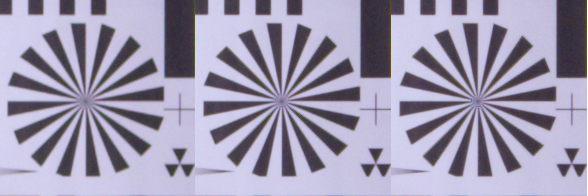
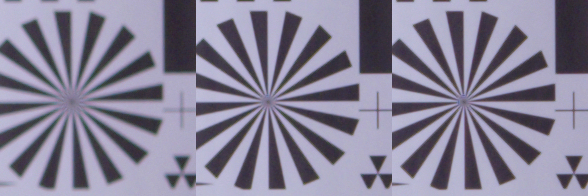
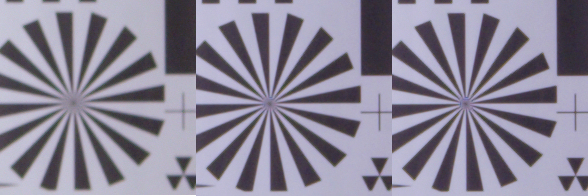
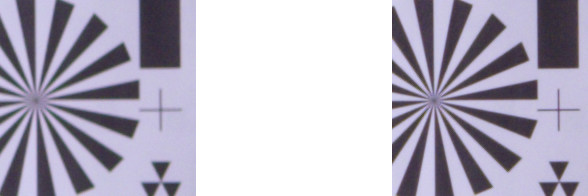
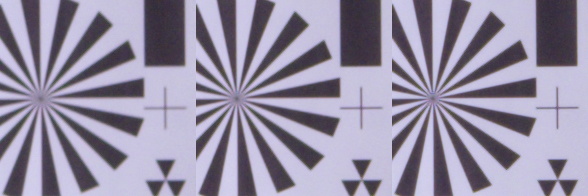
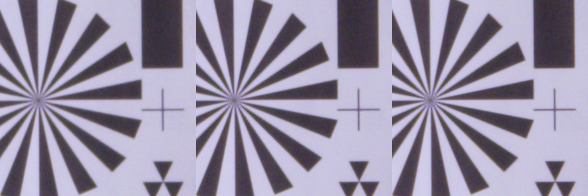
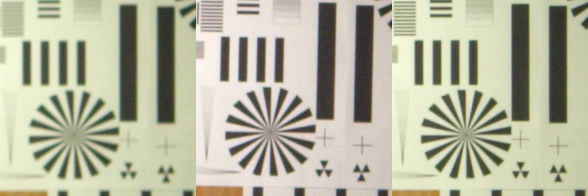
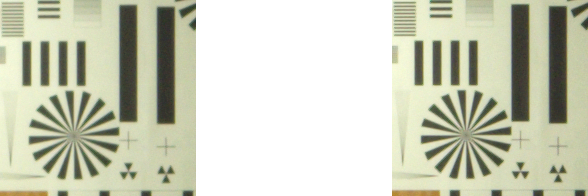
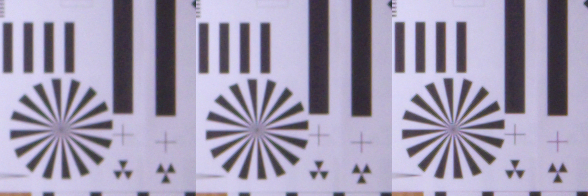

Here's a real-world example. I took the photo below at 2.0x focal length (28.2mm) and f8. The autofocus measured the distance at 1.6m, probably a fairly accurate measurement since the focus distance was so short. The first set of three crops are from the locations marked "1", "2", and "3". Note that location 2, the approximate location of the spot autofocus) is in focus and location 1, closer to the camera, is fairly well focused; location 3, farther from the camera is not in focus (the total calculated DOF for these settings is 1m, so all locations cannot be absolutely sharp). However, if the usual DOF range applied here, then location 3 should be more likely to be in focus, since 70% of the DOF should be on the far side of the focal point. The second set of three crops are at a focus distance of 2.0m. Location 2 is still in focus. Location 3 is now more in focus and location 1 is more out of focus. This confirms my tests which show that the focus distance needs to be increased to obtain a more normal DOF distribution.

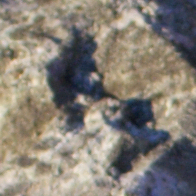
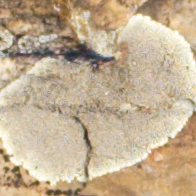
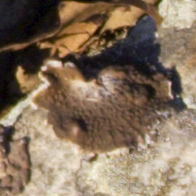
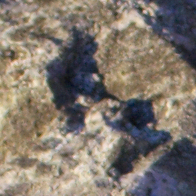

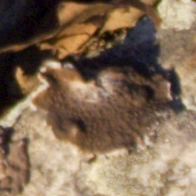
[2006-11-24]
Previously I stated that the "normal" DOF is 30% in front of the focal plane and 70% behind the focal plane. Actually the DOF split varies with focal length, f-stop, and subject distance. In general, the closer the subject distance to the hyperfocal distance, the more the DOF shifts to the rear, because at the hyperfocal distance infinity must be in focus. However, for the focal lengths I have tested (3x, 3.5x, and 4x) and the f-stops (5.0, 5.6, 8.0, 11.0) and subject distances (5m and 10m), the 30%/70% split approaches the average of all the splits. In any case, for all the tested conditions the majority of the DOF is behind the focus distance setting and my testing shows the overwhelming mafority of the R1 DOF to be in the front of the focus distance setting.